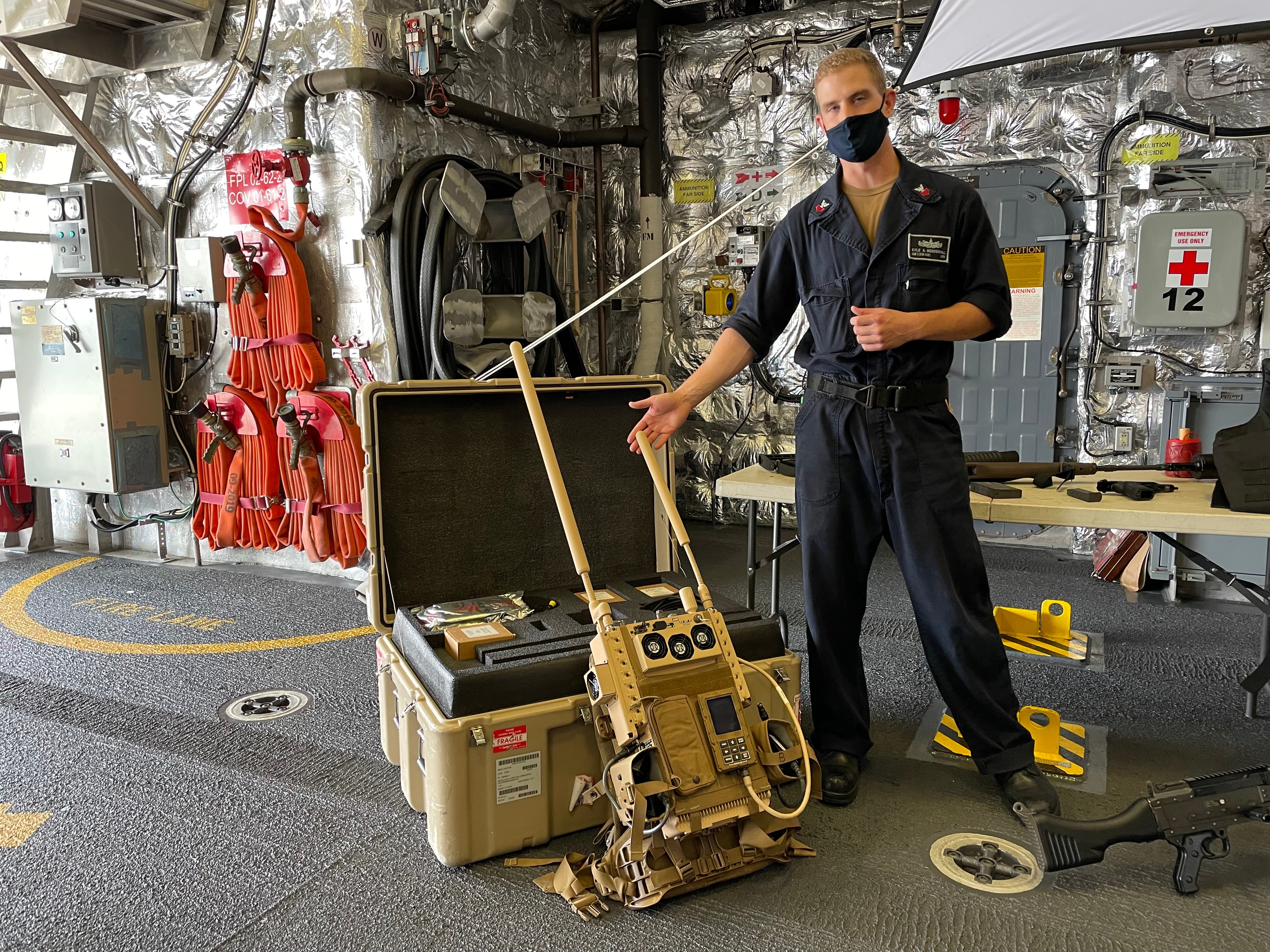
ABOARD THE LITTORAL COMBAT SHIP USS KANSAS CITY, OFF THE COAST OF CALIFORNIA – With the use of drones becoming more prevalent, the Navy has found a way to ensure all of its surface ships can repel unmanned aerial vehicles.
The Drone Restricted Access Using Known Electromagnetic Warfare system, or DRAKE, built by Northrop Grumman and originally used on Humvees during the wars in Iraq and Afghanistan, is now used across the Navy’s surface fleet.
“Anybody these days can kind of just buy a $1500 drone and they can use it to fly over the gates and anything else that they want and come see the ship if they really needed to. So, the Navy saw a very big need for having something to defend ourselves against something so simple that is so common these days,” Gunner’s Mate Kyle Mendenhall told reporters aboard USS Kansas City (LCS-22) last month.
“What this essentially does is it works like a normal jammer. So whenever we have a drone that gets a little bit too close, or flies somewhere that it shouldn’t be, or is in any way, shape or form a risk to us, we can just turn on our DRAKE and the DRAKE will basically keep it from coming close to the ship,” he added. “So it projects basically like an umbrella. So when the drone flies in, this will just cut off the signal.”
The system can be used both off battery power and plugged into the ship. DRAKE was originally mounted on HUMVEES and used to prevent improvised explosive devices (IED) from detonating in Iraq and Afghanistan.
“What this does is it repels drones based on the frequency that they use. So it has pre-programmed frequencies that are common-used frequencies amongst drones and it has the ability to just stop the signal from going,” Mendenhall said. “It won’t necessarily knock them out of the sky, but what it will do – like I said – is as soon as they hit that wall, they can’t go any further.”
With the ability to emanate both high-band and low-band signals, the DRAKE system effectively places a shield around the ship by disconnecting the signal between the operator and the UAV, therefore preventing the drone from coming too close. Operators of the DRAKE can wear the system as a backpack and move around the ship. Kansas City, which has not yet had to use the blocking capability, has multiple DRAKE systems aboard.
“If we encounter a [drone] that happens to come up on the forward-end of the ship, up near the foc’sle, and then it just decides to bolt and go to the aft end on the flight deck, I can just pick this backpack up, I can run to the flight deck and I still keep blocking that signal to make sure the drone stays away from us,” Mendenhall told reporters.
The DRAKE system can also be configured based on the geographical location in which a ship is operating.
“Depending on the AORs, so the area of responsibility that we’re in, we can reconfigure the frequencies that this blocks based on the area that we’re in,” Mendenhall said. “So it doesn’t have to just be specific [to] the one I bought at Target that was $50 . . . we can reconfigure it based on where we’re going.”
While the Navy has for several years been grappling with large Iranian drones operating in the Persian Gulf, the threat to surface ships operating in U.S. Central Command was recently highlighted by an exploding drone that killed two crew members on a merchant tanker off the coast of Oman in July. CENTCOM at the time said samples from the drone used in the attack were “nearly identical to previously collected examples from Iranian one-way attack UAVs.”
The DRAKE system is constantly in use aboard the ship to detect drones, though it’s not always emanating the signals required to block a UAV.
“Every duty section has these available to them. So these are always able to be implemented at any time,” Mendenhall said.
“It’s hard to detect which direction a drone comes from and they can come from the water side and we would never see it, so we always will have one that’s operating to be able to detect and deter.”
In the continental United States, Mendenhall needs authority from the ship’s commanding officer to use the system, but can employ DRAKE if a threat arises.
“If it’s something that we deem a threat, I can turn it on no big deal, and I will backfill basically the chain of command,” he said.
The ship’s anti-terrorism watch officers have the necessary authority to use the blocking system.
“So when we’re in port, we still have use of it,” Mendenhall said. “And we try to refrain from using it, if you will, unless it absolutely is necessary because just because it picks up a signal, doesn’t necessarily mean it’s a threat to us. So it does have a wide range to be able to just detect. But it doesn’t always mean that it’s a threat. Basically, we’d have to see it over our ship to know that it’s a threat to us.”
This isn’t the first system a U.S. Navy ship has used to block a drone threat. During a transit through the Strait of Hormuz in 2019, amphibious assault ship USS Boxer (LHD-4) downed an Iranian drone that came too close. Boxer was likely using an anti-Unmanned Aerial System Marine Air Defense Integrated System (MADIS) that was mounted on a Marine Corps MRZR to take down the drone, USNI News reported at the time.





